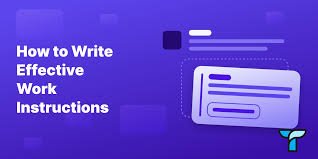In the bustling world of business, clarity is key. Teams are often tasked with executing complex processes, and without clear, actionable guidelines, mistakes can occur, productivity can suffer,and efficiency can decline. This is where effective work instructions come into play. Workinstructions are essential tools that provide step-by-step guidance to ensure tasks arecompleted correctly and consistently. In this article, we’ll explore how to craft work instructionsthat truly enhance your team’s performance and discuss the benefits of using a structured
approach, including a valuable work instruction template.
Understanding Work Instructions
Before diving into the creation process, let’s clarify what work instructions are.Unlike broadpolicies or overarching procedures, work instructions are detailed documents that outline how toperform specific tasks. They are typically aimed at operational staff who need precise,
actionable steps to complete their duties effectively. While policies set thedirection andprocedures lay out the sequence of actions, work instructions focus on the exact stepsnecessary to achieve a particular result.
The Importance of Clear Work Instructions
Clear work instructions are vital for several reasons. They provide a consistent approach to taskexecution, which helps in maintaining quality and reducing errors. When instructions arewell-defined, employees can follow them without confusion, leading to smoother operations anda reduction in training time. Additionally, clear instructions serve as a reference point fortroubleshooting and continuous improvement, making it easier to identify and address issues asthey arise.
Crafting Effective Work Instructions
Creating effective work instructions involves several key steps. Here’s a guide to help youdevelop instructions that are both practical and easy to follow:
- Identify the Task: Start by thoroughly understanding the task at hand. Break it down intomanageable steps to ensure you cover all aspects of the process. This clarity will helpyou draft instructions that are precise and actionable.
- Use Simple Language: Avoid technical jargon or complex terminology. Use
straightforward language that is easy for all team members to understand. The goal is to make instructions accessible to everyone, regardless of their expertise. - Include Visual Aids: Visual aids such as diagrams, screenshots, or flowcharts can significantly enhance comprehension. They provide a visual representation of the steps,which can be particularly useful for complex tasks. Incorporating visuals makes the instructions more engaging and easier to follow.
- Test and Revise: Once you’ve drafted the instructions, test them with a few team members to ensure they are clear and effective. Gather feedback and make necessaryrevisions to improve the instructions. This iterative process helps in refining the contentand addressing any ambiguities.
- Regular Updates: Work instructions should be living documents that evolve withchanges in processes, tools, or team structure. Regularly review and update theinstructions to keep them relevant and accurate. This practice ensures that your teamalways has access to the most current information.
The Role of a Work Instruction Template
To streamline the creation of work instructions, utilizing a structured work instruction template can be incredibly beneficial. A template provides a standardized format that ensuresconsistency across all your documents. It typically includes sections for task descriptions,step-by-step procedures, visual aids, and additional notes. By starting with a template, you can save time and ensure that all essential elements are included. Customize the template to fit the
specific needs of your task and organization, making it a valuable tool for creating comprehensive and effective work instructions.
Implementing Work Instructions in Your Organization
Once you’ve developed your work instructions, it’s crucial to implement them effectively withinyour organization. Ensure that all team members have access to the instructions and are trainedon how to use them. Encourage feedback and make adjustments as needed. Regularly reviewthe instructions to ensure they remain relevant and effective as your organization evolves.
Conclusion
In summary, effective work instructions are a cornerstone of operational efficiency. By creatingclear, actionable guidelines, you can enhance your team’s performance and ensure consistentresults. Investing time in developing and maintaining high-quality work instructions pays off increased productivity, reduced errors, and smoother operations. As you embark on this journey,
remember that clarity and consistency are key to achieving success.
